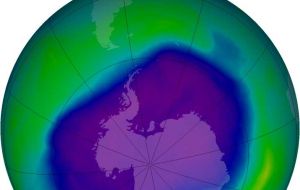MercoPress. South Atlantic News Agency
Ozone hole over Antarctica smallest in five years, says NZ research centre

The ozone hole over Antarctica has shrunk to the smallest in five years, according to a New Zealand’ National Institute of Water and Atmospheric Research, NIWAR. The hole decreased in size to about 22 million square kilometres from 24 million square kilometres last year, said Auckland-based NIWAR in an e-mailed statement today.
“We can’t definitively say the ozone hole is improving from one new year of observations,” NIWA atmospheric scientist Stephen Wood said in the statement. “However, we have now had a few years in succession with less severe holes. That is an indication we may be beginning to see a recovery.”
The ozone layer, which protects humans from carcinogenic ultraviolet radiation, was depleted by man-made compounds such as chlorofluorocarbons (CFCs). Use of CFCs in household items such as refrigerators and aerosol cans was banned by the Montreal Protocol, an international treaty signed in 1987.
The largest ozone hole was recorded in 2000, with an area of about 29 million square kilometres and a 43 million ton mass deficit, according to NIWA. The ozone hole forms in August and September each year and breaks up in November or December.




Top Comments
Disclaimer & comment rulesCommenting for this story is now closed.
If you have a Facebook account, become a fan and comment on our Facebook Page!